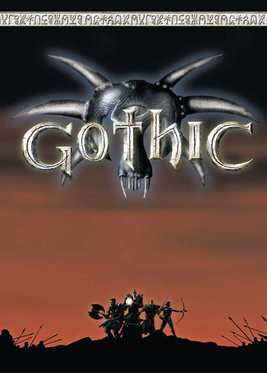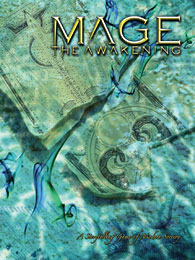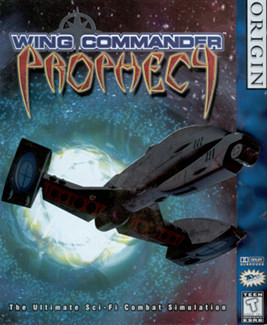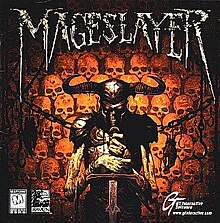
Heretic is a dark fantasy first-person shooter video game released in December 1994. It was developed by Raven Software and published by id Software through GT Interactive.

Hexen: Beyond Heretic is a fantasy first-person shooter video game developed by Raven Software and published by id Software distributed through GT Interactive on October 30, 1995. It is the sequel to 1994's Heretic, and the second game in Raven Software's "Serpent Riders" trilogy, which culminated with Hexen II. The title comes from the German noun Hexen, which means "witches", and/or the verb hexen, which means "to cast a spell". Game producer John Romero stated that a third, unreleased game in this series was to be called Hecatomb.

Hexen II is a dark fantasy first-person shooter (FPS) video game developed by Raven Software and published by id Software in 1997. It is the third game in the Hexen/Heretic series, and the last in the Serpent Riders trilogy. Using a modified Quake engine, it features single-player and multiplayer game modes, as well as four character classes to choose from, each with different abilities. These include the "offensive" Paladin, the "defensive" Crusader, the spell-casting Necromancer, and the stealthy Assassin.

Heretic II is a dark fantasy action-adventure game developed by Raven Software and published by Activision in November 1998 continuing the story of Corvus, the main character from its predecessor, Heretic. It is the fourth game in the Hexen: Beyond Heretic series and comes after the "Serpent Rider" trilogy. Although Id Software owns the publishing rights to the previous titles, Heretic 2 is owned by Activision since they own Raven Software and its IPs.
Raven Software Corporation is an American video game developer based in Middleton, Wisconsin and part of Activision. Founded in May 1990 by brothers Brian and Steve Raffel, the company is most known for its dark fantasy franchise Heretic/Hexen, the first two Soldier of Fortune games, as well as licensed titles based in the Star Wars: Jedi Knight series and Marvel Entertainment's X-Men characters, including 2006's Marvel: Ultimate Alliance. Since 2010, Raven has been developing multiple Call of Duty games as both lead and support developer.

Gothic is a 2001 action role-playing video game developed by Piranha Bytes for Microsoft Windows. A Nintendo Switch port, titled Gothic Classic, was released worldwide on September 28, 2023.

Streets of SimCity is a racing and vehicular combat 3D computer game published by Maxis and Electronic Arts in November 1997. The game features the ability to visit any city created in SimCity 2000, as well as a network mode, allowing for players to play deathmatches with up to seven other players. It is the last Maxis game to be developed and released without supervision by Electronic Arts, which acquired Maxis in the two months leading up to release.
Several video games based on the Magic: The Gathering franchise exist for multiple systems. Some have attempted to translate the card game to electronic play nearly exactly; others have taken more liberties and drawn more from the setting than the actual rules of the card game. Benefits of successful video game versions of the card game include convenience, practice, and challenge. However, artificial intelligence for a game such as Magic is an extremely hard problem, and such software usually must be continuously updated to stay current with recently released card sets. Video game versions often expand on artwork, and may include unique cards that rely on randomness, effects which would be difficult or annoying to duplicate in real life.

Computer Gaming World (CGW) was an American computer game magazine published between 1981 and 2006. One of the few magazines of the era to survive the video game crash of 1983, it was sold to Ziff Davis in 1993. It expanded greatly through the 1990s and became one of the largest dedicated video game magazines, reaching around 500 pages by 1997.

Mage: The Awakening is a tabletop role-playing game originally published by White Wolf Publishing on August 29, 2005, and is the third game in their Chronicles of Darkness series. The characters portrayed in this game are individuals able to bend or break the commonly accepted rules of reality to perform subtle or outlandish acts of magic. These characters are broadly referred to as "mages".

War Wind is a science fantasy real-time strategy game developed by DreamForge Intertainment and published by Strategic Simulations, Inc. (SSI). It was released in 1996 for Microsoft Windows and used DirectX 2.0. The game features four unique playable alien races on the fictional planet of Yavaun, each with their own histories, ideologies, and story campaigns consisting of seven scenarios each and an ending unique to that race. The story explores themes of authoritarianism, slavery, revolution, and mysticism. The game also features a map and scenario editor, as well as netplay with up to seven additional players.
An action role-playing game is a subgenre of video games that combines core elements from both the action game and role-playing genre.

Achtung Spitfire! is a 1997 computer wargame developed by Big Time Software and published by Avalon Hill. It is a turn-based air combat game taking place during the early half of World War II, including fixed-wing aircraft, air battles and operations by Luftwaffe, Royal Air Force and French Air Force in 1939–1943.

Wing Commander: Prophecy is the fifth installment in the Wing Commander science fiction space combat simulator franchise of computer games. The game was released in 1997 for Windows, produced by Origin Systems and distributed by Electronic Arts. In 2003, a Game Boy Advance conversion with added multiplayer was produced by Italy-based Raylight Studios and distributed by Destination Software.

Rage of Mages is a PC game that combines role-playing and real-time strategy. Produced by Nival Interactive it was first released in Russia under the name of Allods: The Seal of Mystery. The game was published in April 1998 in the EU by Buka Entertainment and on October 13, 1998 in the US. It was re-released in 2016 on GOG.com.

Lands of Lore: Guardians of Destiny is a 1997 action role-playing game, second installment of the Lands of Lore series, a sequel to Lands of Lore: The Throne of Chaos. It brought about a drastic change in gameplay style from its predecessor, opting away from the original's D&D turn-based style in favor of more action elements. A sequel, Lands of Lore III, was released in 1999.

Magic: The Gathering is a video game published by MicroProse in March 1997 based on the collectible card game Magic: The Gathering. It is often referred to as Shandalar after the plane of Shandalar, where the game takes place. The player must travel the land and fight random enemies to gain cards, and defeat five wizards representing the five colors. The player must prevent one color from gaining too much power, and defeat the planeswalker Arzakon, who has a deck of all five colors. Adventure and role-playing elements are present, including inventory, gold, towns, dungeons, random battles, and character progression in the form of new abilities and a higher life point total. An oversized version of Aswan Jaguar was included in the game box.

Hellfire, often called Diablo: Hellfire, is an expansion pack for the video game Diablo, developed by Synergistic Software, a Sierra division, and published by Sierra On-Line in 1997. Despite the objections of Blizzard Entertainment, the Hellfire expansion was produced, permitted by Davidson & Associates, their parent company at the time. Blizzard North, who was developing the sequel Diablo II, thus imposed numerous restrictions upon Synergistic Software's development of Hellfire.

Links LS 1999 is a video game developed and published by Access Software for Microsoft Windows in 1998, and is part of the Links video game series.















